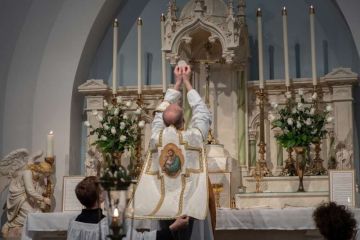Denver Newsroom, Oct 8, 2021 / 16:50 pm
Pope Francis’ restrictions on the Traditional Latin Mass appear to be unpopular among regularly practicing Catholics, but most American Catholics have not even heard of the changes, a survey reports.
“Catholics who attend Mass weekly are both more likely to be aware of the new restrictions and more inclined to oppose them than Catholics who attend less frequently,” the Pew Research Center, which conducted the survey, said Oct. 7
About 58% of Catholics who attended Mass weekly had heard about the restrictions. Regular Mass attendees were the most sceptical of the Pope’s move. Of these, 29% disapproved of the new restrictions, 11% approved, while 17% had no opinion. However, 42% had not heard of the changes.
On July 16, in Traditionis custodes, Pope Francis issued rules giving a bishop “exclusive competence” to authorize the Traditional Latin Mass in his diocese. Bishops with groups celebrating this form of the liturgy in their dioceses are to ensure that the groups do not deny the validity of the Second Vatican Council. The council, held in the 1960s, preceded major changes in the Roman Catholic liturgy. These changes were codified in 1970 with St. Paul VI’s Roman Missal, the missal used in most Catholic parishes in vernacular languages.
The restrictions on the traditional Latin Mass are a break from the practice established in a 2007 apostolic letter from Benedict XVI, Summorum Pontificum, which had acknowledged the rights of all priests to offer the Mass according to the Roman Missal of 1962, promulgated by St. John XXIII.
Overall, some two-thirds of Catholics told Pew that they had heard “nothing at all” about the changes from Pope Francis, 28% had heard “only a little,” while 7% had heard “a lot.” Overall, 9% approved, 12% disapproved, and 14% declined to answer.
Catholics who attend Mass monthly or yearly slightly favored the new restrictions rather than opposed them. Respondents’ opinions appeared not to differ significantly by age. Besides religious practice, Catholics’ favorability towards Traditional Latin Mass restrictions broke along partisan lines.
Among Catholics who are Republicans or lean Republican, only 4% approved the pope’s move, while 20% disapproved. Another 15% had no opinion, while 61% had not heard of the change. By contrast, 13% of Catholics who are Democrats or lean Democrat supported the move, 6% opposed it, 13% had no opinion and some 68% had not heard of it.
Pope Francis said he had issued the restrictions on the Traditional Latin Mass “in defense of the unity of the Body of Christ,” saying, “I am constrained to revoke the faculty granted by my predecessors.” He said permission to celebrate this form of the liturgy had led to “distorted use” that was contrary to the intentions that had allowed it.
In response to the papal action, some bishops have said that priests may continue to offer the Traditional Latin Mass in their dioceses, while others have banned it. Still others have said they need more time to consider their response.
Laity and clergy who support the traditional Latin Mass had their own reactions.
Joseph Shaw, the chairman of the Latin Mass Society of England and Wales, told CNA that many priests and lay Catholics have worked to combine an interest in the Traditional Latin Mass with “sincere loyalty and affection for the hierarchy and the Holy Father.” He said they have been “let down by this document.”
Cardinal Raymond Burke, the former prefect of the Apostolic Signatura, told the National Catholic Register that the text was “marked by a harshness” towards those who attend extraordinary form Masses.
New York Times columnist Ross Douthat was also critical, contrasting the action with Francis’ stress on accompanying people: “Accompaniment for some, slow strangulation of their rites for others.”
It is unclear how many Traditional Latin Mass parishes will be affected by the pope’s new limits and how the limits will affect diocesan clergy and laity who seek to celebrate the Traditional Latin Mass going forward. Catholic parishes that celebrate this Mass are a small minority. As of Oct. 8, the Latin Mass Directory website lists 662 venues in the U.S. By comparison, there are over 16,700 parishes in the U.S., according to the Center for Applied Research in the Apostolate.
Pew’s survey also asked respondents whether they had a favorable or unfavorable view of Pope Francis.
(Story continues below)
American Catholics’ favorability of the pope hovered at about 83%, with Catholics who attend Mass monthly or yearly slightly more favorable towards Pope Francis. Democratic or Democrat-leaning Catholics gave the pope 91% approval, compared to 71% of Republicans or Republican sympathizers. Overall, only 14% of Catholics had an unfavorable view of the pope.
However, 49% of Republican or Republican-leaning Catholics described the pope as too liberal. Only 30% of all Catholics, and 16% of Democratic or Democrat-leaning Catholics said the same.
Strong majorities of Catholic respondents tended to agree that Pope Francis should be described as compassionate, humble, and open-minded, and tended to reject describing him as out of touch or naïve. However, only 52% said he is in good physical health, and Republican or Republican-leaning respondents tended to be less positive in their descriptions of the pope.
American Catholics tend to be more favorable towards Pope Francis than Americans overall. Only 60% of all U.S. respondents had a favorable view of the pontiff, with 28% voicing an unfavorable view.
The Pew Research Center’s survey of 6,485 U.S. adults, 1,374 of whom are Catholic, was conducted Sept. 20-26 as part of Pew’s American Trends Panel. Pew said the survey is weighted to be representative of the U.S. adult population by sex, race, ethnicity, party affiliation, education, religious affiliation and other categories.
The survey claims a margin of error of plus or minus 1.9 percentage points for all Americans, plus or minus 4.3 percentage points for all Catholics, and plus or minus 8.4 percentage points for Catholics who attend Mass at least weekly.






